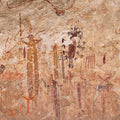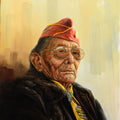Award-winning Earl Biss documentary released on streaming platforms
By Medicine Man Gallery on

Earl Biss, 'Four Chiefs, a Dog and a Boy,' (1983). Oil on canvas, 60 x 84 | Photo Courtesy Chadd Scott
My favorite artist is Earl Biss. Number two, Vincent van Gogh.
When I say Earl Biss is my favorite artist, I’m not grading on a scale. I don’t mean my favorite American painter or Native American artist; I mean my favorite artist.
Looking at his paintings – and this happened from the very first instance I ever saw one – I felt a spiritual connection to them, and him, unlike anything before or since. That first time was at the James Museum of Western and Wildlife Art in Saint Petersburg, FL and I remember the moment as distinctly as I do seeing my wife for the first time.
Lisa Gerstner‘s documentary, “Art of Native America: Earl Biss – The Spirit Who Walks Among His People,” released in late April of 2023 on Amazon Prime, Vimeo and Vudu, beautifully shares Biss’ genius and spirit.
The film’s production and Gerstner’s background with Biss were previously profiled by “Essential West.”
An astonishing trove of video footage and photographs from throughout Biss’ life highlights the production. Biss was born in 1947 and raised on the Apsáalooke Reservation in Montana. It’s not surprising video and pictures exist from when Biss was an artworld superstar in highfalutin Aspen, CO in the 1980s, how so many pictures and video were taken, let alone remain, of the artist’s childhood – including early childhood photos with his grandmother who raised him when he couldn’t have been more than 3-years-old – is miraculous.
This was 60 years before everyone held a camera and video recorder in their pocket. These items couldn’t have been cheap or commonplace on the Reservation.
Not long before his death, Biss candidly revealed his thoughts on art, life, spirituality and indigeneity during an extensive, on-camera, sit-down interview from 1997 which the film incorporates extensively. The years have started wearing on him in this footage. The hard living.
By that time, he’s no longer the lithe, energetic artist he was even earlier that decade, vibrant, full of vim and vinegar, painting in darkened basements with both hands at the same time, removed from this physical world yet plugged in to another, spiritual world.
His Apsáalooke name was Iláaxe Baahéeleen Díilish: the Spirit Who Walks Among His People.
“I’m holding the brush and someone else is doing the painting and the thinking,” Biss is quoted in the documentary.
Footage of him painting recalls Michael Jordan dunking from the free throw line or Jimi Hendrix playing guitar. Staggering genius. You can’t believe your eyes.
Earl Biss at IAIA
Beyond a biography of Earl Biss, the film adeptly documents the so-called “Miracle Generation” of initial enrollees at the Institute of American Indian Arts in Santa Fe. It was Earl Biss and Kevin Red Star and Doug Hyde and T.C. Canon and Linda Lomahaftewa and their classmates under the direction of Lloyd Kiva New and Fritz Scholder and Allan Houser and Charles Loloma who invented Contemporary Native American Art.
Nothing like it existed before.
In the same way that Monet, Renoir, Dégas and their colleagues invented Impressionism and forever altered the course of Modern art, Biss and his contemporaries similarly invented a genre, one which has yet to achieve its zenith, gaining greater recognition every day in the hands of their successors, most prominent among them now, Wendy Red Star, Biss’ niece.
She’s Kevin Red Star’s niece as well, and if the film has a co-star to Biss and his artwork, it’s Biss’ long-time friend, second cousin, IAIA classmate and fellow Apsáalooke, Red Star, who refers to Biss as “little brother.”
Numerous intimate photographs from these early days at IAIA are shown in the movie. An amazing sequence of Biss dressed in regalia clowning around with T.C. Canon wearing street clothes stands out.
Remarkable items of Biss ephemera from the voluminous collection of the IAIA Native Artist Files are seen. News clippings, gallery show opening announcements, a college recommendation letter for Biss written by Scholder. IAIA at this time was a high school.
We see Biss’ artist statement hand-written on a yellow, lined notepad.
It reads: “I feel that the inborn flair for art is due to my Indian background. I believe that my sense of balance and color was passed down by my ancestors and this sense cannot be lost even though tradition is not portrayed in my work.”
Earl Biss Stories
They’re true. All of them.
The stories you hear about Earl Biss.
My personal favorite comes from Bill Rey, owner of Claggett/Rey Gallery in Edwards, CO. Rey’s been working the art scene in the Colorado mountain resort towns since Biss’ career was at its apex. He remembers a scheduled show opening for Biss on a Friday night. An hour before the show, there was no artwork.
Minutes before opening, Biss and some friends – he always had a lot of friends – pull up in a dump truck with a load of giant, wet canvasses in the back. Masterpieces produced in a frenzied trance of activity which could have lasted multiple days uninterrupted by sleep. Biss tended to paint that way at the time.
They all sold.
He was selling paintings for in excess of $50,000 in the mid-80s when that was real money, even in Aspen and Vail.
Not that he kept any of that money.
Another of my favorite Biss stories is how he was advanced something like $20,000 the night of a gallery opening by the owner and come Monday, he was back asking for the rest of his cut because he’d spent it all.
Biss lived for the moment. Cadillacs. Champagne. Drugs. He lived the monied, celebrity, 80s lifestyle as outrageously as any actor or rock star. In Aspen, he co-debauched with fellow wild man and gonzo journalism creator Hunter S. Thompson.
The film makes no attempt to hide this, nor should it. Biss was not perfect by any means.
He was a womanizer. He was married about 10 times – a precise accounting of wives no more possible than a precise accounting of the number of oil paintings he produced. He drank hard. He partied hard. Hard drugs. Jail time. IRS trouble.
His mischievous smile a window into his soul.
But Biss was never mean or nasty or violent. Through Gerstner’s interviews with Biss’ ex-wives, family, friends, his attorney, the former sheriff of Pitkin County where Aspen is located, colleagues, collectors and his adopted son Dante Biss-Grayson, a successful artist himself, Earl Biss is revealed as playful, generous, the life of the party, the Spirit Who Walks Among His People.
Postscript
Earl Biss suffered a massive stroke on October 18, 1998, in his Santa Fe studio, crossing over at the age of 51. For most people, that seems young. Biss squeezed at least 100 years of experiences into his 51.
His most recent 51, anyway. Biss firmly believed he had lived past – and would likely live future – lives.
He loved, he laughed, he saw the world, he helped invent an artform, he made a fortune, he spent a fortune, he helped uphold his culture, and he found a calling at which he possessed a unique brilliance he is still esteemed for today.
Gerstner magnificently reveals this in her film.
Iláaxe Baahéeleen Díilish.

Earl Biss, Early Snow in the Beartooth Range. Oil on canvas. Collection of Paul Zuger | Photo Courtesy Chadd Scott




